Japanese paper techniques elevate your soap presentation with mindful artistry. Try Origata folding for adhesive-free elegance, Washi paper pleating for breathable maturation, Furoshiki-inspired knotting for eco-friendly wrapping, Mizuhiki cord accents for symbolic touches, vibrant Chiyogami patterns for eye-catching gifts, Shodo-style minimalism with calligraphy elements, and traditional Japanese aesthetic principles emphasizing balance and simplicity. These techniques transform ordinary soap into meaningful gifts that honor Japanese cultural traditions while creating a multisensory unwrapping experience.
7 Best Japanese Paper Techniques For Wrapping Soap
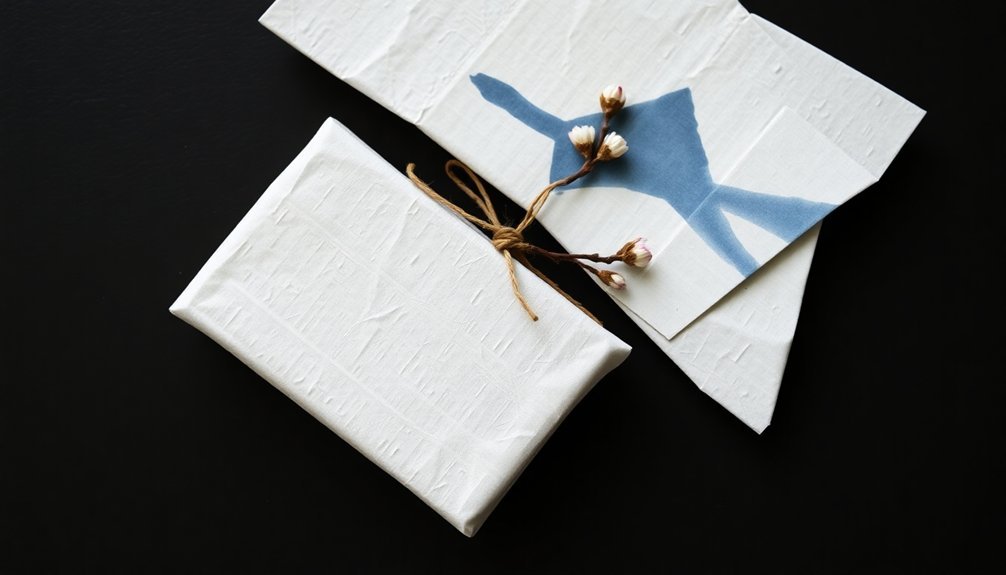
The rich tradition of Japanese paper wrapping offers soap artisans and enthusiasts exceptional methods to elevate their presentations.
When packaging your handcrafted soaps, furoshiki cloth wrapping provides a reusable, eco-friendly option that's both practical and beautiful.
Washi paper delivers an elegant solution with its breathable qualities that allow soaps to mature while protected.
Enhance your presentation by securing washi paper with decorative washi tape instead of plastic adhesives.
For a sophisticated touch, try origata folding techniques that require no glue or tape, creating stunning packages through precise folds alone.
Consider vibrant chiyogami papers for eye-catching patterns that showcase your brand's aesthetic, or incorporate kintsugi-inspired designs to symbolize beauty in imperfection.
These traditional Japanese methods transform simple soap bars into meaningful gifts worthy of display.
The Elegant Origata Method for Gift-Quality Presentation
Elevating beyond ordinary packaging, origata stands as perhaps the most refined Japanese wrapping technique you'll encounter when presenting handcrafted soaps.
This traditional method transforms simple washi paper into an elegant soap packaging solution without cuts or adhesives—relying solely on precise, meaningful folds.
You'll appreciate how origata emphasizes the soap's natural beauty while the thoughtful folding process symbolizes your gratitude toward the recipient.
The technique requires just a square of quality washi paper, allowing the craftsmanship of your folding to become part of the gift itself.
For a personalized touch, add natural twine or a minimalist label to your origata-wrapped soap.
The result is a gift presentation that honors Japanese aesthetic principles while creating an unwrapping experience as special as the soap inside.
Washi Paper Pleating for Textured Soap Wraps
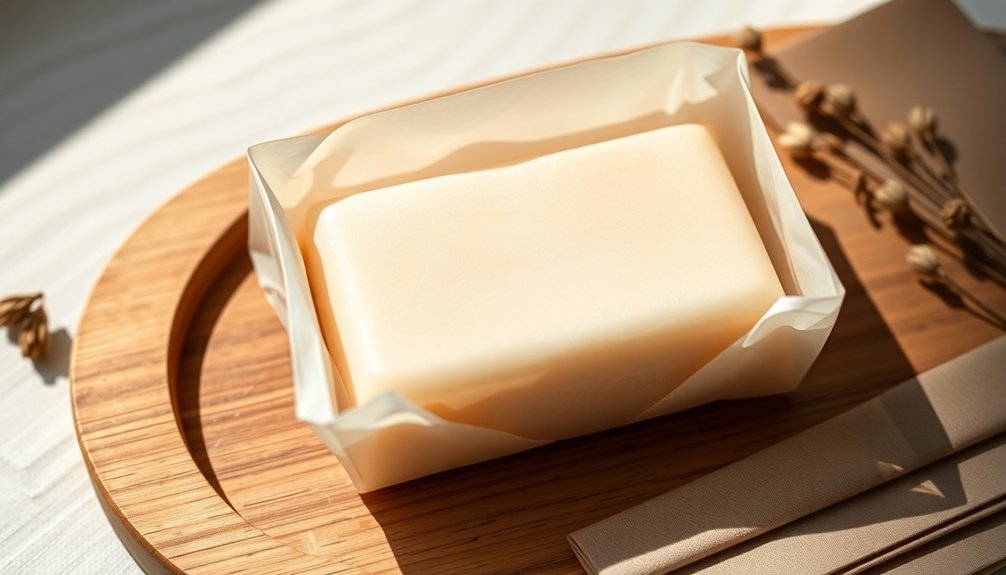
Washi paper pleating offers you a versatile way to create textured soap wraps that range from simple accordion folds to intricate radial designs.
You'll need quality washi sheets in complementary colors to your soap, a bone folder for precise creases, and patience for mastering the technique.
These lightweight yet durable pleated wraps not only protect your soaps but transform them into visually stunning products that customers will remember.
Pleating Techniques Explored
Several pleating techniques can transform ordinary washi paper into stunning textured wraps for your handcrafted soaps. Using a ruler guarantees your folds are evenly spaced, creating that professional, uniform appearance that elevates your packaging.
| Pleating Style | Difficulty | Best For |
|---|---|---|
| Accordion | Beginner | Linear designs |
| Box Pleat | Intermediate | Dimensional look |
| Sunburst | Advanced | Circular soaps |
The lightweight nature of washi paper makes it perfect for intricate folds while maintaining its structural integrity. You'll find that these pleats not only add visual interest but also serve as a protective layer for your soap. When properly executed, your pleated washi paper wrapping creates an artisanal finish that transforms everyday soaps into gift-worthy treasures with distinct Japanese aesthetic appeal.
Materials and Applications
Beyond just knowing the techniques, selecting the right materials for your soap wrapping endeavors will greatly impact the final presentation.
When working with pleated designs, choose washi paper that balances flexibility with structure—papers that are too thin won't hold pleats effectively, while overly thick varieties may crack.
Washi paper's natural breathability makes it perfect for soap wrapping, allowing your products to maintain freshness while preventing moisture buildup.
You'll find the biodegradable nature of washi aligns perfectly with eco-conscious consumers who value sustainable packaging.
Select colors and patterns that complement your soap's ingredients and scents. A lavender-infused soap pairs beautifully with soft purple washi, while citrus soaps pop against bright yellow or orange papers.
Consider adding personalized stamps or labels to your pleated wraps for distinctive branding opportunities.
Furoshiki-Inspired Paper Knotting Techniques
Rooted in centuries of Japanese tradition, Furoshiki paper knotting offers a beautiful approach to soap wrapping that combines elegance with practicality.
You'll find this eco-friendly technique transforms ordinary paper into stunning packaging while eliminating wasteful tape and ribbons.
The basic furoshiki method involves folding your square paper's corners toward the center, creating a secure pouch that adapts perfectly to your soap's dimensions.
For special gifts, try the decorative "bunny ear" knot by tying opposite corners to form charming loops that enhance visual appeal.
- Create a sustainable impression using reusable or recyclable paper
- Customize your wrapping style based on the recipient's preferences
- Adjust the technique for different soap shapes and sizes without cutting
Traditional Mizuhiki Cord Accents for Soap Packaging
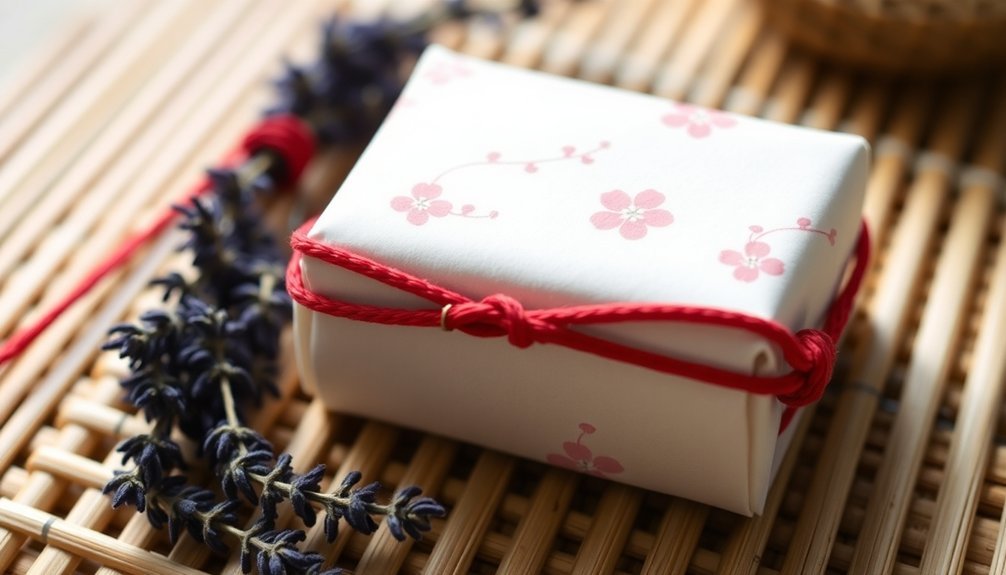
Mizuhiki cord accents on your handmade soaps can convey specific meanings through their colors, with red and white symbolizing celebration, while gold and silver represent elegance and prosperity.
You'll find that mastering basic knot techniques like the musubi-cho (butterfly knot) or awaji-musubi (good fortune knot) transforms simple soap packaging into meaningful gifts.
These traditional Japanese paper cords can be wrapped around soap bars or attached to tags, creating visual impact while honoring the cultural significance behind each carefully crafted knot.
Cord Color Symbolism
The ancient art of Mizuhiki cord decoration transforms ordinary soap packaging into meaningful gifts through its rich color symbolism.
When you select Mizuhiki colors for your soap wrapping, you're not just making an aesthetic choice—you're conveying specific sentiments to your recipient.
- Red Mizuhiki represents celebration and joy, perfect for birthday or holiday soap gifts.
- White cords symbolize purity and new beginnings, ideal for wedding favors or bath products.
- Gold and silver convey prosperity and good fortune, elevating luxury soap presentations.
Knot Tying Techniques
While mastering the art of Mizuhiki cord decoration may seem intimidating at first, you'll find that learning a few essential knot techniques can transform your soap packaging into memorable gifts.
The traditional "Musubi" knot is particularly effective when securing your wrapping paper around soaps, creating a secure yet elegant presentation.
You'll appreciate how Mizuhiki's washi paper cords remain flexible yet durable, allowing you to create intricate knots that hold their shape beautifully.
Try matching cord colors to your soap's fragrance—red for floral scents or blue for ocean-inspired varieties.
Each knot carries cultural significance beyond mere decoration.
When you tie these traditional Japanese knots, you're not just wrapping soap—you're conveying good fortune and happiness to your recipient, making your handcrafted gift truly meaningful.
Chiyogami Paper Folding for Colorful Soap Presentation
Renowned for its kaleidoscopic patterns and rich cultural heritage, Chiyogami paper transforms ordinary soap into a visually stunning gift. This lightweight yet durable paper, crafted from rice or mulberry fibers, provides both protection and elegance to your handcrafted soaps.
When folding Chiyogami paper around your soap, focus on creating precise creases that highlight the paper's intricate designs. Select patterns that complement your soap's fragrance—floral prints for lavender soaps or geometric patterns for citrus varieties.
- Choose contrasting colors that reflect your soap's theme for maximum visual impact
- Incorporate traditional Japanese knots like shide or furoshiki ties for authentic presentation
- Layer different Chiyogami patterns for a dimensional effect that makes your soap stand out
Minimalist Shodo-Style Wrapping With Calligraphy Elements
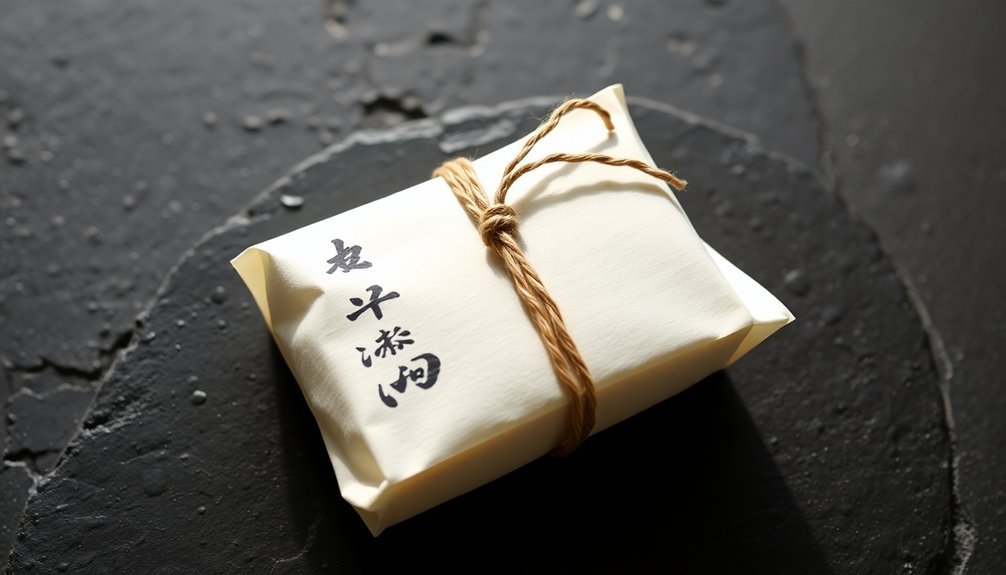
In stark contrast to the vibrant Chiyogami approach, Shodo-style wrapping embraces the Japanese concept of "ma"—finding beauty in emptiness and space.
This elegant technique allows the natural texture of high-quality washi paper to speak for itself, creating a sophisticated presentation for your handcrafted soaps.
Incorporate your own brushwork calligraphy onto the paper for a deeply personal touch.
Even simple kanji characters add artistic dimension while preserving the minimalist aesthetic.
Choose natural, muted tones that evoke tranquility and complement the soap inside.
The tactile quality of textured washi paper enhances the unwrapping experience, engaging multiple senses.
Complete your presentation with a small handwritten tag featuring Shodo calligraphy—transforming your soap gift into a mindful experience that honors Japanese artistic traditions.
Frequently Asked Questions
What Paper Is Best for Wrapping Soap?
For wrapping soap, you'll find unbleached wax paper provides excellent moisture protection. Kraft paper offers eco-friendly durability, tissue paper gives a soft presentation, and biodegradable cellophane showcases your soap while keeping it protected.
What Is the Best Thing to Wrap Soap In?
The best soap wrapping options include unbleached wax paper, kraft paper, or biodegradable cellophane. You'll find that breathable materials preserve your soap while sustainable choices like fabric wraps offer reusable, eco-friendly packaging alternatives.
How Do You Wrap Soap in Paper?
Center your soap on a paper rectangle. Fold sides over snugly, securing overlapping edges with tape. You'll want the paper to hug the soap completely. Add a ribbon and label for a personalized touch.
What Packaging Options Are Best for Storing Handmade Soap?
For storing handmade soap, you'll want breathable options like wax paper, kraft paper, or recycled cardboard boxes. Don't forget organza bags for gifting. Always make certain your packaging allows the soap to cure properly.
In Summary
These Japanese paper techniques aren't just functional—they transform your soaps into artistic gifts worth treasuring. Whether you've chosen the elegant Origata method or incorporated Mizuhiki cords, you'll create packaging that honors both your handmade soap and Japanese aesthetic traditions. Try combining different techniques for your own signature style. Your recipients won't just appreciate the soap inside; they'll cherish the thoughtful wrapping that makes your creation truly special.

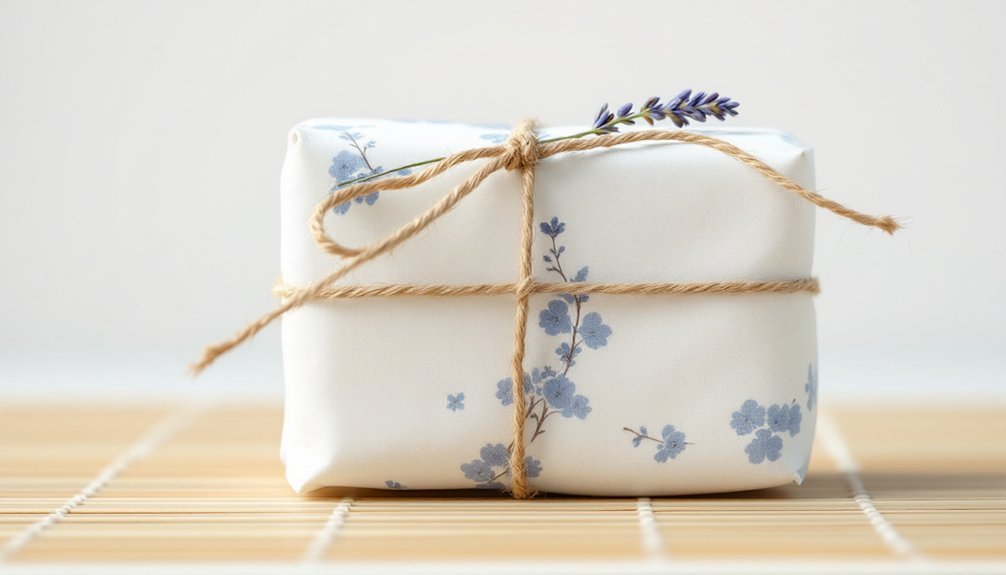



Leave a Reply